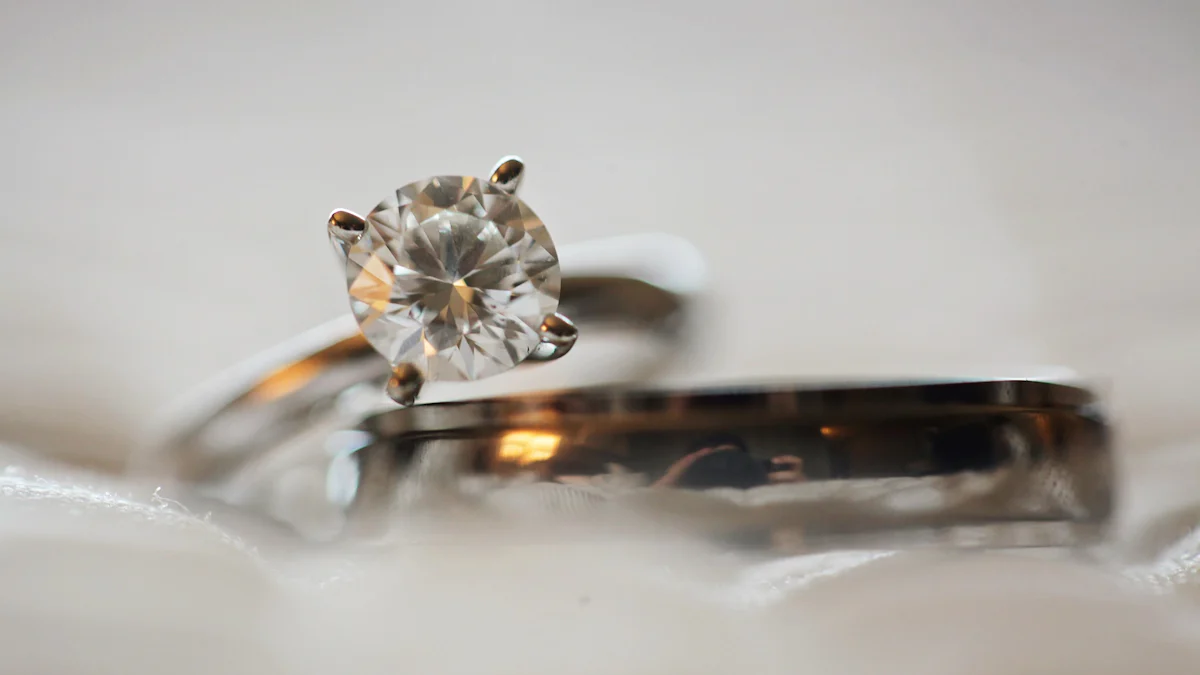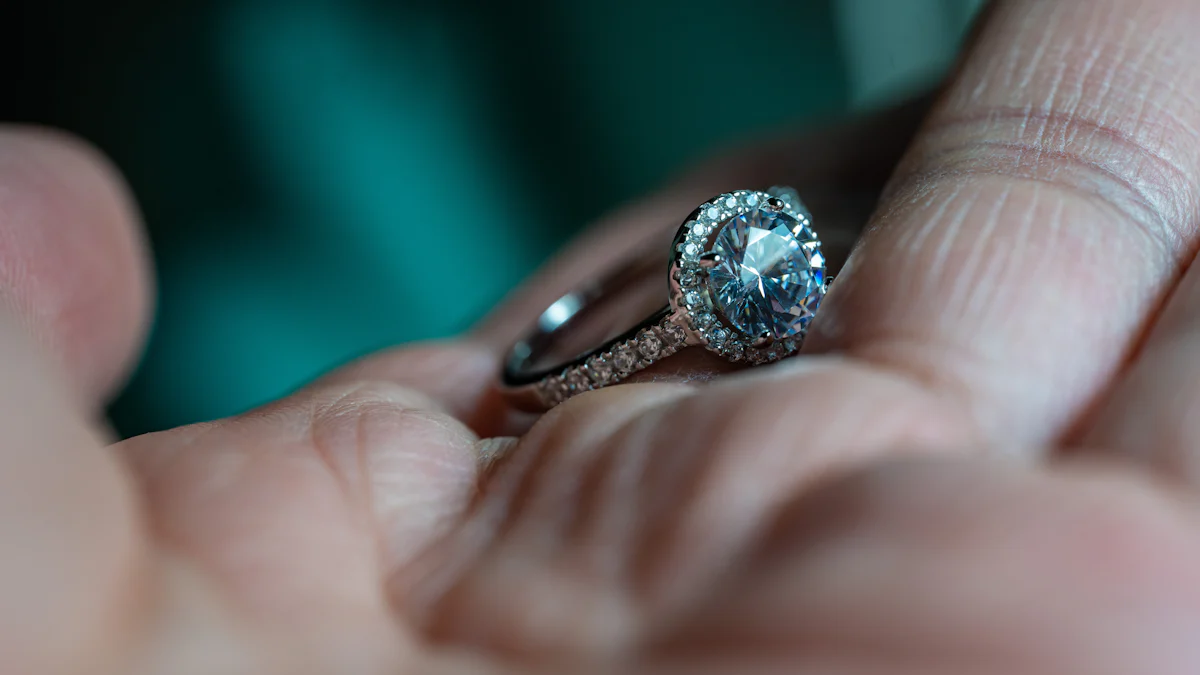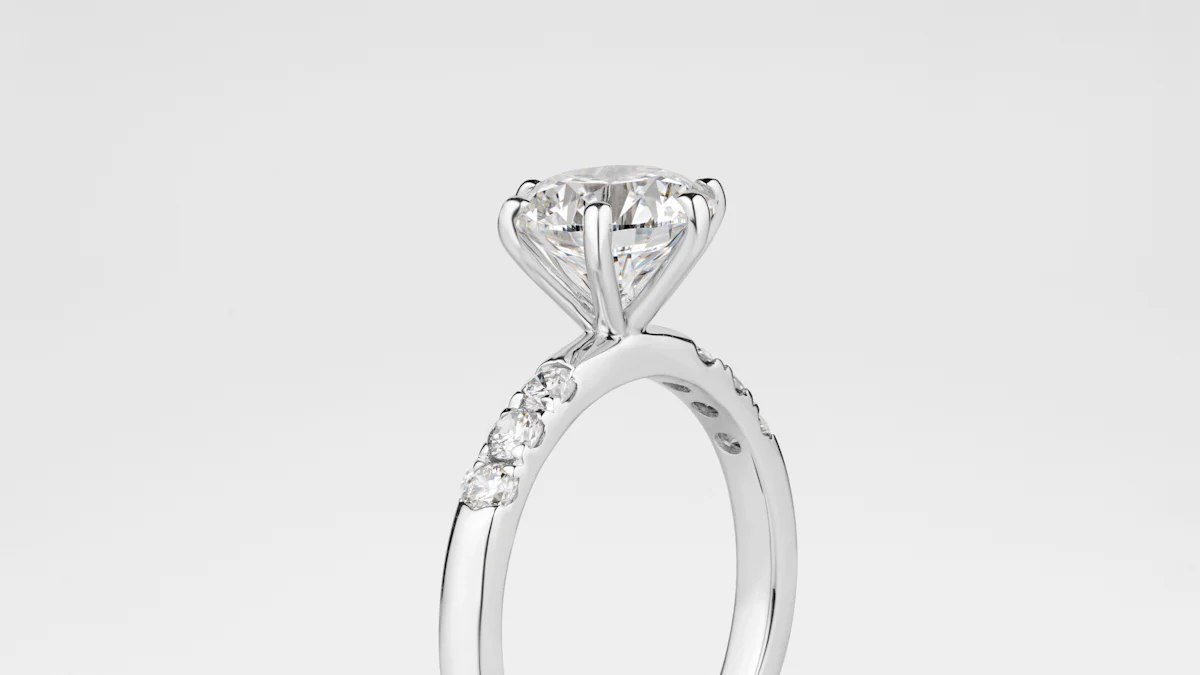Understanding 2ct Diamond Solitaire Ring Quality

When you consider purchasing a 2ct diamond solitaire ring, understanding its quality becomes essential. The quality of such a ring hinges on the Four Cs: cut, color, clarity, and carat. Each factor plays a pivotal role in determining the diamond's value and appearance. A well-cut diamond reflects light brilliantly, enhancing its sparkle. Clarity assesses the presence of inclusions or blemishes, impacting the stone's purity. Color grading ranges from colorless to light yellow, influencing the diamond's allure. Carat weight signifies size, with a 2ct diamond offering a substantial visual impact. These factors guide your decision, ensuring you choose a ring that meets your expectations.
Key Takeaways
- Understand the 4 Cs: Carat, Cut, Color, and Clarity are crucial in evaluating a diamond's quality and value.
- Aim for a color grade between D and H for a 2ct diamond to ensure it appears nearly colorless and maximizes visual appeal.
- Choose a well-cut diamond to enhance its brilliance; a superior cut significantly impacts the diamond's sparkle and overall beauty.
- Balance clarity with other factors; a diamond with slightly lower clarity can still be stunning if it excels in cut and color.
- Select a setting style that complements your personal taste and lifestyle, whether it's a classic prong, modern bezel, or unique tension setting.
- Consider the differences between natural and lab-grown diamonds to align your choice with your values and budget.
- Work with a reputable jeweler to ensure the authenticity and quality of your diamond, and compare options to find the best fit for your needs.
The 4 Cs of Diamond Quality

Carat
Understanding carat weight
When you explore the world of diamonds, carat weight becomes a fundamental concept. Carat refers to the weight of the diamond, with one carat equaling 200 milligrams. This measurement helps you understand the size of the diamond. A 2ct diamond solitaire ring offers a substantial presence, making it a popular choice for those seeking a bold statement piece.
Impact of carat on appearance and value
Carat weight significantly influences both the appearance and value of a diamond. Larger diamonds, like a 2ct stone, often appear more impressive and command higher prices. However, it's essential to balance carat weight with other quality factors to ensure the diamond's overall beauty and value.
Cut
How cut affects brilliance
The cut of a diamond plays a crucial role in its brilliance. A well-cut diamond reflects light beautifully, creating a dazzling sparkle. The cut determines how light travels through the diamond and returns to your eye. A poorly cut diamond may appear dull, regardless of its carat weight or clarity.
Popular cuts for solitaire rings
When selecting a 2ct diamond solitaire ring, consider popular cuts like round, princess, and emerald. Each cut offers a unique aesthetic, influencing the ring's overall appearance. Round cuts are renowned for their brilliance, while princess cuts provide a modern, angular look. Emerald cuts, with their step-like facets, offer a sophisticated and elegant appeal.
Color
Color grading scale
Diamonds are graded on a color scale ranging from D (colorless) to Z (light yellow). The less color a diamond has, the higher its quality and value. Colorless diamonds allow more light to pass through, enhancing their brilliance and appeal.
Ideal color range for 2ct diamonds
For a 2ct diamond, aim for a color grade between D and H. This range ensures the diamond appears nearly colorless, maximizing its visual impact. While higher color grades may come at a premium, they contribute significantly to the diamond's overall allure and value.
Clarity
Clarity grading and inclusions
When you evaluate a diamond, clarity becomes a key factor. Clarity refers to the absence of inclusions and blemishes within the stone. These imperfections can affect the diamond's appearance and value. The Gemological Institute of America (GIA) provides a clarity grading scale that ranges from Flawless (FL) to Included (I). A Flawless diamond shows no inclusions under 10x magnification, making it extremely rare and valuable. On the other hand, an Included diamond has obvious inclusions visible to the naked eye, which can diminish its appeal.
Understanding this grading scale helps you assess the quality of a diamond. Most diamonds have some level of inclusions, but many are not visible without magnification. When you choose a diamond, consider how these inclusions might impact its beauty and price.
Balancing clarity with other factors
While clarity is important, you should balance it with the other Cs—carat, cut, and color. A diamond with a high clarity grade may not always be the best choice if it lacks in other areas. For instance, a diamond with excellent cut and color but slightly lower clarity can still offer stunning brilliance and appeal.
When selecting a 2ct diamond solitaire ring, aim for a clarity grade that complements the other quality factors. You might find that a diamond with a Slightly Included (SI) or Very Slightly Included (VS) grade offers a good balance between clarity and cost. These grades often provide a visually clean appearance without the premium price of higher clarity grades.
Ultimately, your choice should reflect your personal preferences and budget. By understanding clarity and its role in diamond quality, you can make an informed decision that ensures your ring meets your expectations.
Specific Considerations for 2ct Diamonds
Size and Shape
Visual impact of a 2ct diamond
When you choose a 2ct diamond solitaire ring, its size makes a significant visual statement. A 2ct diamond stands out due to its substantial carat weight, offering a bold and impressive appearance. This size captures attention and often becomes the centerpiece of any jewelry collection. The larger surface area of a 2ct diamond allows it to reflect more light, enhancing its brilliance and sparkle. You will find that this size not only elevates the ring's presence but also adds a touch of luxury and elegance to your ensemble.
Choosing the right shape for solitaire settings
Selecting the right shape for your 2ct diamond is crucial. Different shapes offer unique aesthetics and can influence how the diamond appears in a solitaire setting. Popular shapes include round, princess, and emerald cuts. A round cut maximizes brilliance and is a classic choice for solitaire rings. The princess cut, with its sharp angles, provides a modern and stylish look. An emerald cut, known for its step-like facets, exudes sophistication and elegance. When choosing a shape, consider your personal style and how the diamond will complement the setting and your overall look.
Proportions and Symmetry
Importance of well-proportioned diamonds
The proportions of a diamond significantly affect its overall beauty and value. Well-proportioned diamonds reflect light more effectively, enhancing their brilliance and fire. When you evaluate a 2ct diamond, pay attention to its depth and table percentages. These measurements determine how light interacts with the diamond. A diamond with ideal proportions will appear more vibrant and lively. Poorly proportioned diamonds may look dull or lifeless, regardless of their size or clarity. Ensuring your diamond has the right proportions is essential for maximizing its visual appeal.
Evaluating symmetry in 2ct diamonds
Symmetry plays a vital role in the quality of a diamond. Symmetrical diamonds have facets that align perfectly, allowing light to reflect evenly across the stone. This alignment enhances the diamond's sparkle and overall appearance. When assessing a 2ct diamond, examine its symmetry by looking at the alignment of its facets and the uniformity of its shape. A diamond with excellent symmetry will exhibit a balanced and harmonious look, contributing to its allure and value. Prioritizing symmetry ensures that your diamond solitaire ring maintains its beauty and elegance over time.
Pricing Factors
Influence of Cut and Clarity on Price
How cut quality affects cost
The cut quality of a diamond significantly impacts its price. When you choose a diamond with an excellent cut, you ensure that it reflects light beautifully, enhancing its sparkle. This brilliance makes the diamond more desirable and valuable. Diamonds with superior cuts often command higher prices because they maximize the stone's visual appeal. A well-cut diamond can appear larger and more vibrant, making it a worthwhile investment.
Clarity's role in pricing
Clarity also plays a crucial role in determining a diamond's price. Diamonds with fewer inclusions or blemishes are rarer and more valuable. When you select a diamond with high clarity, you pay a premium for its purity and flawlessness. However, you can find diamonds with slight inclusions that are not visible to the naked eye, offering a balance between quality and cost. By understanding clarity's impact on pricing, you can make informed decisions that align with your budget and preferences.
Natural vs. Lab-Grown Diamonds
Differences in cost and quality
Natural and lab-grown diamonds differ in both cost and quality. Natural diamonds, formed over millions of years, often carry a higher price tag due to their rarity and traditional appeal. In contrast, lab-grown diamonds offer a more affordable option while maintaining similar visual qualities. These diamonds are created in controlled environments, allowing for precise control over their characteristics. When you consider lab-grown diamonds, you gain access to high-quality stones at a fraction of the cost of natural ones.
Pros and cons of lab-grown diamonds
Lab-grown diamonds present several advantages and disadvantages. On the positive side, they provide an eco-friendly and ethical alternative to natural diamonds. You can enjoy the beauty of a diamond without contributing to environmental concerns associated with mining. Additionally, lab-grown diamonds offer excellent value for money, allowing you to purchase a larger or higher-quality stone within your budget.
However, some people prefer the historical and sentimental value of natural diamonds. Lab-grown diamonds may lack the unique story and rarity that natural stones possess. When deciding between natural and lab-grown diamonds, consider your priorities and values. By weighing the pros and cons, you can choose a diamond that aligns with your personal preferences and ethical considerations.
Selecting the Ideal 2ct Diamond Solitaire Ring

Choosing the perfect 2ct diamond solitaire ring involves more than just selecting a beautiful diamond. You must also consider the setting style and the reputation of the vendor. These factors ensure that your ring not only looks stunning but also holds its value and quality over time.
Setting Styles
Popular solitaire settings
When it comes to solitaire settings, several styles stand out for their timeless appeal and ability to showcase the diamond. The prong setting is the most popular choice, featuring small metal claws that hold the diamond securely while allowing maximum light exposure. This setting enhances the diamond's brilliance and sparkle. Another favored option is the bezel setting, which encircles the diamond with a thin metal rim, offering a modern look and added protection. The tension setting creates an illusion of the diamond floating between the band, providing a contemporary and sleek appearance.
Matching setting style with personal taste
Your personal taste plays a crucial role in selecting the right setting style. Consider your lifestyle and preferences when choosing a setting. If you lead an active lifestyle, a bezel setting might offer the durability you need. For those who prefer a classic and elegant look, the prong setting remains a timeless choice. The tension setting suits individuals seeking a unique and modern design. By aligning the setting style with your personal taste, you ensure that your 2ct diamond solitaire ring becomes a cherished piece that reflects your individuality.
Reputable Vendors
Tips for finding trustworthy jewelers
Finding a reputable jeweler is essential to ensure the quality and authenticity of your diamond ring. Start by researching jewelers with positive reviews and strong reputations. Look for certifications from recognized organizations like the Gemological Institute of America (GIA) or the American Gem Society (AGS). These certifications guarantee that the diamonds meet high standards of quality and ethics. Additionally, seek recommendations from friends or family who have had positive experiences with jewelers. Visiting multiple stores allows you to compare prices and services, helping you make an informed decision.
Online vs. in-store purchasing
Deciding between online and in-store purchasing depends on your comfort level and preferences. Online retailers often offer competitive prices and a wide selection of diamonds. They provide detailed information and images, allowing you to make an informed choice from the comfort of your home. However, purchasing in-store offers the advantage of seeing the diamond in person and receiving personalized assistance from knowledgeable staff. You can try on different settings and get a feel for the ring's appearance and fit. Both options have their benefits, so consider what aligns best with your needs and expectations.
Summary of Key Points
Recap of the 4 Cs
Understanding the 4 Cs—carat, cut, color, and clarity—is essential when evaluating a 2ct diamond solitaire ring. Each factor plays a crucial role in determining the diamond's overall quality and value:
-
Carat: This measures the weight of the diamond. A 2ct diamond offers a substantial presence, making it a popular choice for those seeking a bold statement piece.
-
Cut: The cut affects the diamond's brilliance. A well-cut diamond reflects light beautifully, enhancing its sparkle and appeal.
-
Color: Diamonds are graded on a scale from D (colorless) to Z (light yellow). Aim for a color grade between D and H for a 2ct diamond to ensure it appears nearly colorless.
-
Clarity: This refers to the absence of inclusions and blemishes. A higher clarity grade typically results in a more valuable stone. Balancing clarity with other factors is key to finding a diamond that meets your expectations.
Practical Advice for Buyers
When purchasing a 2ct diamond solitaire ring, consider the following practical tips to ensure a wise investment:
-
Work with a Trusted Jeweler: Partner with a knowledgeable and accredited jeweler. This ensures a smooth buying experience and guarantees the authenticity of your diamond. The Gemological Institute of America (GIA) emphasizes the importance of buying from a trusted source.
-
Compare Within Your Budget: Evaluate diamonds within your budget to find the best balance of the 4 Cs. Comparing options helps you understand what features are most important to you and how they affect the price.
-
Consider Setting and Style: Choose a setting that complements the diamond and reflects your personal taste. Popular settings like prong, bezel, and tension offer different aesthetics and levels of protection.
-
Evaluate Natural vs. Lab-Grown Diamonds: Decide whether a natural or lab-grown diamond aligns with your values and budget. Lab-grown diamonds offer similar visual qualities at a lower price point, while natural diamonds carry traditional appeal.
By keeping these points in mind, you can make an informed decision that ensures your 2ct diamond solitaire ring is both beautiful and valuable.
Understanding the quality factors of a 2ct diamond solitaire ring is essential for making an informed purchase. The 4Cs—carat, cut, color, and clarity—are crucial in determining a diamond's beauty and value. By prioritizing these aspects, you ensure that your choice aligns with your expectations and budget. Remember, each factor contributes uniquely to the diamond's overall appeal. As you explore options, balance these elements to find a ring that truly resonates with your personal style and preferences. This knowledge empowers you to make a confident and satisfying decision.
FAQ
What are the 4Cs of diamond quality?
The 4Cs stand for Carat weight, Cut, Color, and Clarity. These factors determine a diamond's quality and value. Understanding them helps you make informed decisions when purchasing a diamond.
How does carat weight affect a diamond's appearance?
Carat weight measures a diamond's size. Larger diamonds, like a 2ct stone, often appear more impressive. However, balancing carat weight with other quality factors ensures the diamond's overall beauty.
Why is the cut of a diamond important?
The cut affects a diamond's brilliance. A well-cut diamond reflects light beautifully, enhancing its sparkle. Poorly cut diamonds may look dull, regardless of their size or clarity.
What is the ideal color range for a 2ct diamond?
For a 2ct diamond, aim for a color grade between D and H. This range ensures the diamond appears nearly colorless, maximizing its visual impact and allure.
How does clarity influence a diamond's value?
Clarity refers to the absence of inclusions and blemishes. Diamonds with higher clarity grades are rarer and more valuable. Balancing clarity with other factors is key to finding a diamond that meets your expectations.
What are the popular cuts for solitaire rings?
Popular cuts include round, princess, and emerald. Round cuts maximize brilliance, princess cuts offer a modern look, and emerald cuts provide sophistication and elegance.
How do natural and lab-grown diamonds differ?
Natural diamonds form over millions of years and often carry a higher price tag. Lab-grown diamonds offer similar visual qualities at a lower cost. They provide an eco-friendly and ethical alternative.
What should I consider when choosing a setting style?
Consider your lifestyle and personal taste. Prong settings enhance brilliance, bezel settings offer durability, and tension settings provide a modern look. Choose a style that complements your diamond and reflects your individuality.
How can I find a reputable jeweler?
Research jewelers with positive reviews and certifications from recognized organizations like the GIA. Seek recommendations from friends or family. Visiting multiple stores helps you compare prices and services.
Should I buy a diamond ring online or in-store?
Online retailers offer competitive prices and a wide selection. In-store purchases allow you to see the diamond in person and receive personalized assistance. Choose the option that aligns with your comfort level and preferences.
See Also
Exploring Engagement Ring Diamond Cuts And Their Significance
A Comprehensive Review Of Kay Jewelers Diamond Rings
Essential Elements That Influence Diamond Ring Prices

